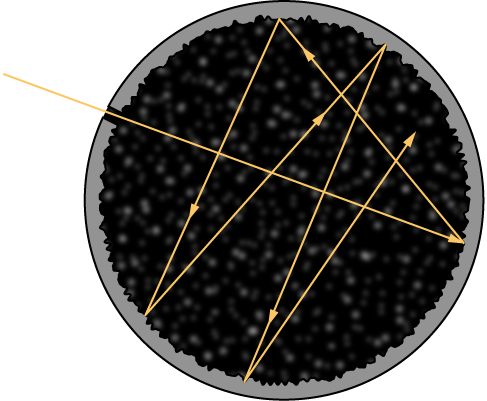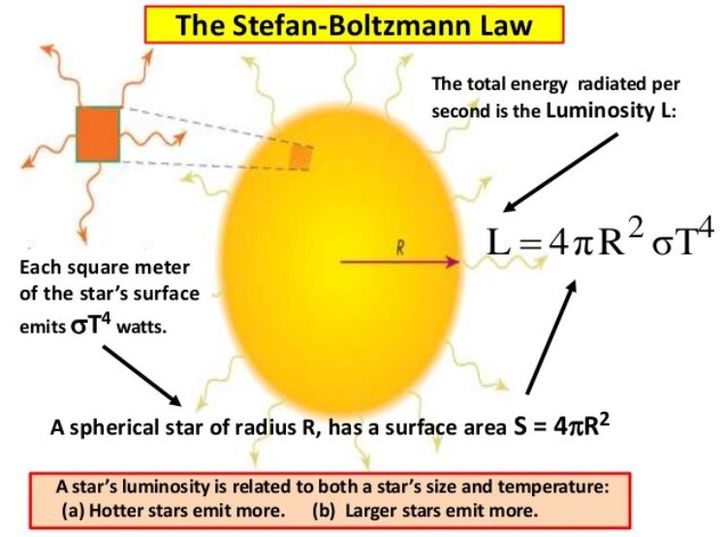Stefan Boltzmann Law or Stefan’s law is an important law in thermodynamics. It relates the energy radiated by a blackbody to its temperature.
It is called the Stefan-Boltzmann law after the two scientists who had major roles in its development, Josef Stefan and Ludwig Boltzmann.
Index
The Law
What is a Blackbody?
A blackbody is an ideal body that is studied in physics, especially in thermodynamics. It is a body that perfectly absorbs and emits all wavelengths of light. Though it does not exist in reality, it is a useful tool to model some situations.
An associated value for blackbody is radiant emittance. It is the energy radiated by the blackbody, per unit surface area, per unit time. It is a total measured over all wavelengths.

Mathematical Statement
The law relates radiant emittance (j*) of a blackbody to its temperature.
Specifically, it says that the radiant emittance is proportional to the fourth power of absolute temperature (T, in Kelvin).
The formula of Stefan’s law is as following

where,
σ is the Stefan’s Constant equal to 5.67 * 10-8.W m-2 K-4
j* is the radiant emittance
T is the temperature in Kelvin
In other words, a hotter body emits more power per unit area than a cooler one.
Implications
An important property of blackbodies is that all blackbodies are identical. This law reflects that property.
We see that the radiant emittance depends solely on the temperature of the blackbody, and nothing else. This means that whatever the structure of the blackbody is, its radiant emittance varies only with its temperature.
The law has been verified experimentally as well. Scientists have designed bodies that can absorb almost all energy incident upon them. These thus are technically blackbodies, and their energy emittance satisfies Stefan’s Law.
Development in History
From Experimental Data
Josef Stefan originally obtained the law in 1879 by studying experimental data regarding power emitted by a platinum filament.
He obtained that the emittance of the filament was proportional to the fourth power of its absolute temperature. He used this to calculate the temperature of the sun, arriving at a figure in between 5400 and 5700 K.
From Theory
Ludwig Boltzmann arrived at the same law from thermodynamics theory, in 1884. He extended the work of Adolfo Bartoli on radiation pressure to arrive at this result.
Planck derived the result too, as part of his work on spectral data of blackbody radiation. His quantum theory of blackbody radiation helped provide a new perspective for the origins of Stefan’s law.
Applications
Not just the sun, we can obtain the temperature of any star from Stefan’s Law.
To find the temperature of any star, astronomers use luminosity of the star. It is basically the product of radiant emittance and surface area of the star.

The law works here because stars behave as almost perfect blackbodies. As the radiant emittance depends on the temperature, so does luminosity.
Once we have a value of the luminosity, we can estimate the temperature by plugging in the values into the law.
This can also help in many other calculations. Knowing the temperature and luminosity of the star can help us deduce other facts. For example, we could estimate the mass of the star and its type. This could help us analyze the galaxy the star is in, too.
So, that was an overview of Stefan’s law, its development and applications.
FAQ
Stefan’s law states that the energy radiated by the blackbody, per unit surface area, per unit time at all the wavelengths is proportional to the fourth power of absolute temperature
The law is very important in astrophysics where it can be used to obtain the temperature of any star. Moreover, it can also be used in finding mass of a star, analyzing the star and the galaxy the star is located in.

